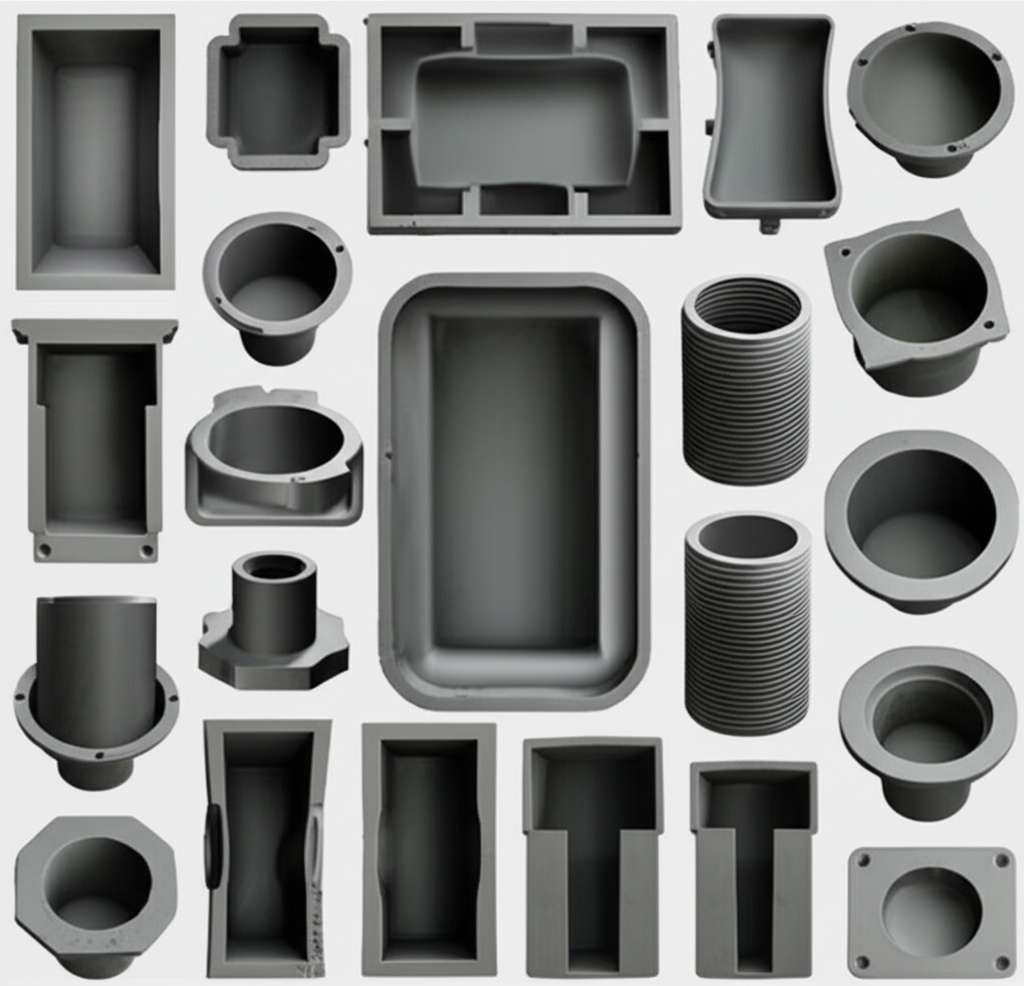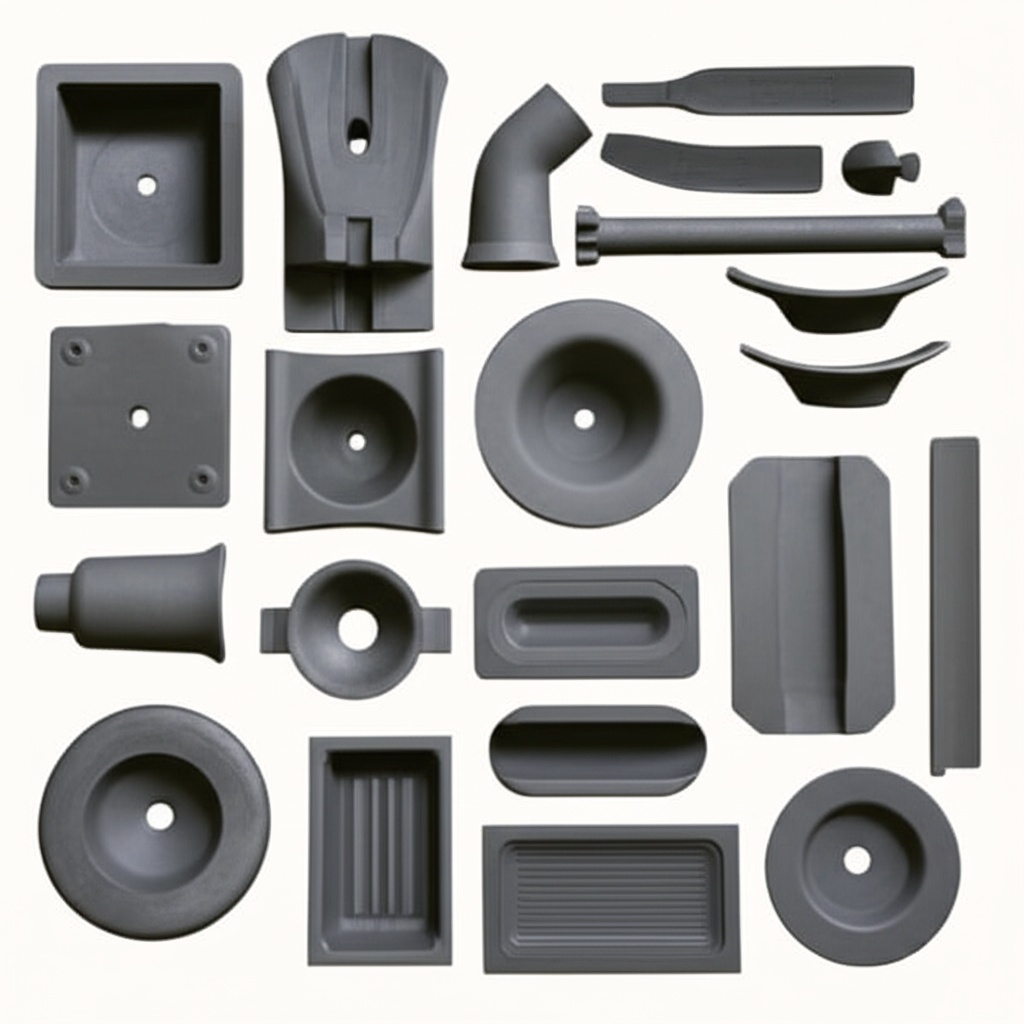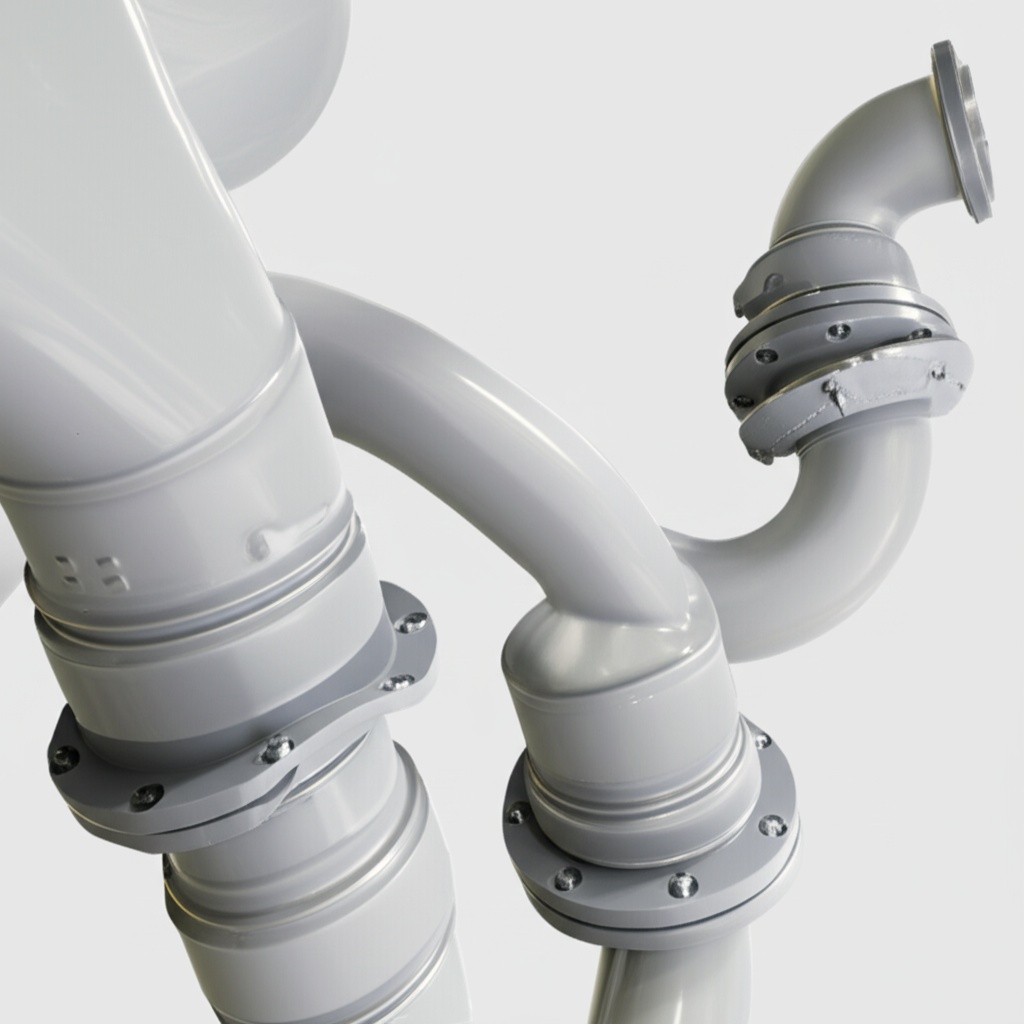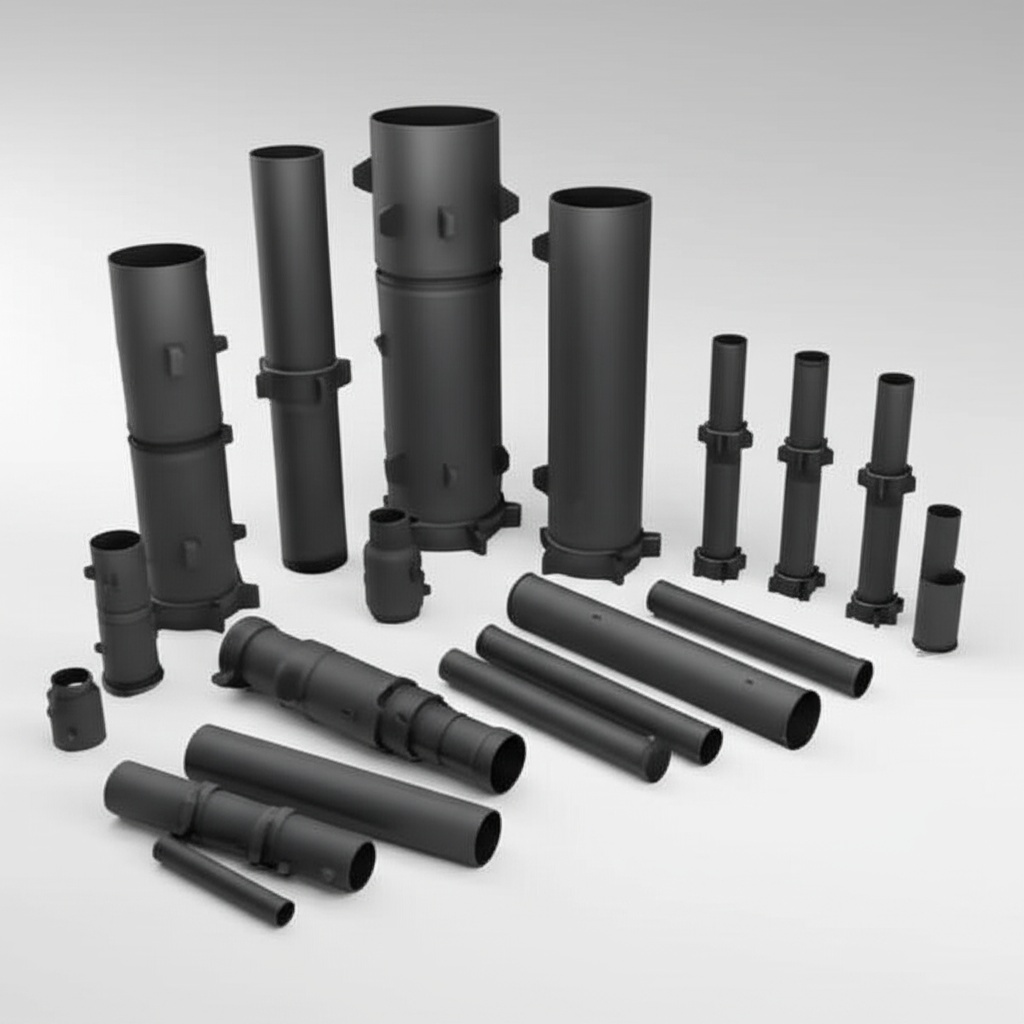SiC Driving Efficiency in Modern EV Motor Designs

Share
SiC Driving Efficiency in Modern EV Motor Designs
Introduction: The Pivotal Role of Custom Silicon Carbide in High-Performance EV Motors
The electric vehicle (EV) revolution is rapidly accelerating, driven by consumer demand for sustainable transportation and stringent emissions regulations. At the heart of this transformation lies the electric motor, where performance, efficiency, and reliability are paramount. Silicon Carbide (SiC), an advanced ceramic material, is emerging as a game-changer in EV motor design and manufacturing. Unlike traditional silicon-based semiconductors and structural materials, SiC offers superior thermal conductivity, higher switching frequencies, and greater power density. This translates directly into EVs with longer range, faster charging capabilities, and more compact, lighter powertrain systems. Custom silicon carbide products are particularly essential as they allow engineers to tailor components to the unique and demanding specifications of modern EV motor environments. From inverters to motor housings and power modules, SiC components are engineered for optimal performance under extreme conditions, including high temperatures, high voltages, and significant mechanical stress. The ability to customize SiC parts ensures precise integration, maximizing the material’s inherent benefits and pushing the boundaries of EV technology. As industries from automotive to aerospace seek materials that can withstand harsh operating conditions while improving efficiency, the demand for expertly engineered SiC solutions continues to grow, underscoring its critical role in next-generation high-performance applications.
Main Applications of Silicon Carbide Beyond EV Motors
While its impact on EV motors is profound, silicon carbide’s exceptional properties make it indispensable across a multitude of demanding industries. Before delving deeper into EV motor specifics, it’s important to recognize the versatility of this advanced material. In the semiconductor industry, SiC is a cornerstone for manufacturing wafers, wafer carriers, and components for chemical vapor deposition (CVD) and etching equipment due to its high purity, thermal stability, and resistance to chemical attack. The aerospace and defense sectors rely on SiC for lightweight armor, mirror substrates for optical systems, and components in high-temperature gas turbines and rocket nozzles, where its strength-to-weight ratio and thermal shock resistance are critical. In high-temperature furnace construction and metallurgical operations, SiC heating elements, kiln furniture (beams, rollers, plates), and thermocouple protection tubes offer extended service life and energy efficiency. The power electronics industry widely uses SiC for diodes, MOSFETs, and power modules that operate at higher voltages, temperatures, and frequencies than their silicon counterparts, enabling more compact and efficient power conversion systems. Furthermore, its wear resistance makes it ideal for mechanical seals, bearings, and nozzles in industrial machinery and chemical processing. Even in LED manufacturing, SiC substrates are used for growing GaN epitaxial layers, contributing to brighter and more efficient lighting solutions. This broad applicability underscores the fundamental advantages of SiC as a high-performance technical ceramic.
Why Choose Custom Silicon Carbide for EV Motors?
The specific operating conditions within an electric vehicle motor—high temperatures, rapid thermal cycling, high electrical fields, and significant mechanical stresses—demand materials that go beyond the capabilities of conventional options. Custom silicon carbide (SiC) components offer a compelling suite of advantages tailored for this challenging environment, making them a preferred choice for engineers striving for peak EV performance and reliability.
- Superior Thermal Management: SiC possesses exceptionally high thermal conductivity (often 3-5 times higher than aluminum or copper on a weight basis) and excellent thermal shock resistance. In EV motors, this means SiC components like inverter baseplates or direct cooling elements can efficiently dissipate heat generated by power electronics and motor windings. This leads to cooler operation, enhanced reliability of surrounding components, and the potential for increased power density without overheating.
- Enhanced Power Density and Efficiency: SiC-based power modules (inverters and converters) can operate at much higher switching frequencies and temperatures than traditional silicon (Si) devices. This allows for smaller, lighter, and more efficient power electronics, directly impacting the EV’s overall weight, range, and performance. Custom SiC substrates and packaging materials are crucial for maximizing these benefits.
- Exceptional Mechanical Properties: SiC exhibits high hardness, excellent wear resistance, and high elastic modulus. For structural components within or associated with the motor, such as bearings, seals, or even potentially integrated housing elements, custom SiC parts can offer superior durability and longevity, especially in environments with abrasive particles or high friction.
- Electrical Insulation and High Voltage Capability: Many SiC formulations offer excellent electrical insulation properties at high temperatures, which is critical for isolating high voltage components within the compact confines of an EV powertrain. Custom designs can optimize insulation paths and creepage distances.
- Chemical Inertness: SiC is highly resistant to coolants, lubricants, and other chemicals found within an automotive environment. This chemical inertness ensures long-term stability and prevents degradation of critical components, contributing to the motor’s overall lifespan.
- Design Flexibility through Customization: The ability to procure custom SiC components allows engineers to design parts optimized for specific functions and spatial constraints within the EV motor assembly. This includes complex geometries, integrated features, and precise interfaces, which might not be achievable with off-the-shelf solutions. This is where partnering with a specialist like Sicarb Tech for expert customizing support can unlock significant design advantages.
By choosing custom SiC, automotive companies can push the boundaries of EV motor design, achieving higher efficiency, greater power density, improved thermal management, and enhanced durability, all contributing to a superior electric vehicle.
Recommended SiC Grades for EV Motor Components
Selecting the appropriate grade of silicon carbide is crucial for optimizing the performance and longevity of EV motor components. Different manufacturing processes yield SiC materials with varying properties, making certain grades more suitable for specific applications within the motor and its associated power electronics. Key considerations include thermal conductivity, electrical resistivity, mechanical strength, and cost-effectiveness.
| SiC Grade | Key Characteristics | Typical EV Motor Related Applications | Advantages |
|---|---|---|---|
| Sintered Silicon Carbide (SSC / SSiC) | High density (>98%), excellent strength, high thermal conductivity, exceptional wear and corrosion resistance. Typically fine-grained. | Power module substrates, heat sinks, precision mechanical seals, bearings, lightweight structural components. | Superior mechanical properties, excellent thermal performance, high purity. |
| Reaction-Bonded Silicon Carbide (RBSC / SiSiC) | Contains free silicon (typically 8-15%), good thermal conductivity, good wear resistance, complex shapes possible, relatively lower manufacturing cost. | Larger structural components, heat exchangers, components requiring complex geometries where cost is a significant factor. | Cost-effective for complex shapes, good thermal shock resistance, good dimensional stability. |
| Nitride-Bonded Silicon Carbide (NBSC) | Porous structure, good thermal shock resistance, good strength at high temperatures, resistant to molten metals. | Less common directly in motors, but potentially for fixtures or tooling in motor component manufacturing. More prevalent in metallurgical applications. | Excellent thermal shock resistance, high-temperature strength. |
| Recrystallized Silicon Carbide (RSiC) | High porosity (10-20%), excellent thermal shock resistance, good for very high temperatures. | Heating elements (for testing rigs), kiln furniture for processing motor components. | Exceptional thermal shock resistance, stable at very high temperatures. |
| CVD Silicon Carbide (CVD-SiC) | Ultra-high purity, theoretically dense, excellent surface finish, superior chemical resistance. | Protective coatings on components, high-purity semiconductor applications (less direct in motor structure, more in chip-level). | Highest purity, exceptional chemical resistance and surface properties. |
| Direct Sintered Silicon Carbide (DSSC) | Achieves high density without sintering aids, leading to enhanced thermal and electrical properties. | High-performance heat sinks, substrates for power electronics demanding maximum thermal dissipation. | Very high thermal conductivity, excellent electrical properties. |
For most EV motor applications, particularly in power electronics modules (inverters, converters) that control the motor, Sintered Silicon Carbide (SSiC) and potentially high-performance grades of Reaction-Bonded Silicon Carbide (RBSC) are primary candidates. SSiC offers the best combination of thermal conductivity, mechanical strength, and electrical insulation for substrates and heat spreaders. RBSC can be a good alternative for larger, more complex shapes where its cost-effectiveness and good thermal properties are advantageous. The choice will ultimately depend on the specific performance requirements, operating conditions, and cost targets of the EV motor component. Consulting with experienced SiC material specialists is vital to make the optimal selection.
Design Considerations for SiC Components in EV Motors
Designing components with silicon carbide for EV motors requires careful consideration of the material’s unique properties, particularly its hardness and brittleness, alongside its exceptional thermal and electrical capabilities. Effective design ensures manufacturability, reliability, and optimal performance within the demanding automotive environment.
- Simplicity and Manufacturability: While SiC can be formed into complex shapes, simpler geometries are generally more cost-effective to manufacture. Minimize sharp internal corners and drastic changes in cross-section, as these can become stress concentration points. Incorporate generous radii where possible. Early collaboration with a custom SiC manufacturer can provide crucial DFM (Design for Manufacturability) feedback.
- Managing Brittleness: Unlike metals, SiC does not yield plastically before fracture. Designs must account for this by avoiding tensile stresses where possible and protecting components from impact loads. Consider compressive loading designs. Finite Element Analysis (FEA) is crucial to identify high-stress areas and optimize the geometry to stay well within the material’s strength limits.
- Wall Thickness and Aspect Ratios: Minimum achievable wall thickness depends on the SiC grade and manufacturing process (e.g., SSiC vs. RBSC). Very thin sections or extremely high aspect ratios can be challenging and costly to produce and may be more prone to fracture. Aim for robust, well-supported structures.
- Integration with Other Materials: EV motors involve assemblies of various materials. Consider the coefficient of thermal expansion (CTE) mismatch between SiC and adjoining metallic parts (e.g., copper busbars, aluminum housings). Compliant interlayers, brazing techniques, or mechanical clamping designs may be needed to accommodate differential expansion and prevent stress buildup.
- Electrical Design for Power Modules: For SiC substrates in power modules, consider layout for optimal current paths, minimizing parasitic inductance and capacitance. Ensure adequate creepage and clearance distances for high voltage insulation. The superior dielectric strength of SiC can be leveraged, but careful design is still paramount.
- Thermal Management Features: Design SiC components to maximize their thermal conductivity benefits. This might involve integrated cooling channels (for liquid cooling), optimized surface areas for heat dissipation, or direct bonding paths to heat-generating devices.
- Tolerances and Interfaces: Specify tolerances that are achievable and necessary for the function. Overly tight tolerances significantly increase manufacturing costs. Clearly define critical interface surfaces and their required flatness or finish.
- Edge Conditions: Chamfering or radiusing edges can improve the strength of SiC parts by removing potential crack initiation sites created during machining or handling. This is especially important for components subjected to mechanical or thermal stresses.
Successful design with SiC in EV motors is a holistic process, balancing the extraordinary capabilities of the material with practical manufacturing and assembly considerations. Engaging with material experts early in the design cycle is key to leveraging SiC’s full potential.
Tolerance, Surface Finish & Dimensional Accuracy in SiC EV Motor Parts
Achieving precise dimensional accuracy, specified tolerances, and appropriate surface finishes is critical for the functionality and reliability of silicon carbide components in EV motors. Given SiC’s extreme hardness, machining and finishing processes are specialized and can significantly impact the final cost and performance of the part. Understanding the capabilities and limitations is essential for engineers and procurement professionals.
Tolerances:
- As-Sintered Tolerances: Parts directly from the sintering furnace (for SSiC or RBSC) will have wider tolerances, typically in the range of ±0.5% to ±2% of the dimension, depending on the size, complexity, and specific SiC grade. For many applications, as-sintered tolerances may be sufficient and more cost-effective.
- Machined Tolerances: For applications requiring higher precision, such as bearing surfaces, seal faces, or precise interfaces in power module assemblies, SiC components undergo diamond grinding. Machined tolerances can be significantly tighter:
- Standard ground tolerances: ±0.025 mm to ±0.05 mm (±0.001″ to ±0.002″) are commonly achievable.
- Precision ground tolerances: Down to ±0.005 mm to ±0.01 mm (±0.0002″ to ±0.0004″) can be achieved with specialized processes and increased cost.
- Ultra-precision: Tolerances below ±0.005 mm are possible but require highly specialized equipment and significantly impact cost and lead time.
Surface Finish:
- As-Sintered Finish: The surface finish of as-sintered SiC parts typically ranges from Ra 1.0 µm to Ra 5.0 µm (40 µin to 200 µin), depending on the forming method and SiC grade.
- Ground Finish: Diamond grinding can produce surface finishes in the range of Ra 0.2 µm to Ra 0.8 µm (8 µin to 32 µin). This is often suitable for dynamic seal surfaces and interfaces requiring good thermal contact.
- Lapped/Polished Finish: For applications demanding exceptionally smooth and flat surfaces, such as high-performance substrates for direct chip attachment or optical-grade finishes (though less common in typical motor parts), lapping and polishing can achieve surface finishes below Ra 0.025 µm (1 µin). These processes add considerable cost.
Dimensional Accuracy & Stability:
Silicon carbide exhibits excellent dimensional stability over a wide temperature range due to its low coefficient of thermal expansion and high stiffness. Once manufactured to the required dimensions, SiC components maintain their shape and size even under significant thermal and mechanical loads, which is a critical advantage in precision EV motor assemblies. The key is to ensure the initial manufacturing accuracy meets the design requirements.
Key Considerations for Procurement and Design:
- Specify Only Necessary Precision: Over-specifying tolerances or surface finishes significantly increases manufacturing costs due to the difficulty of machining SiC. Clearly identify critical dimensions and surfaces that require tight control.
- Consult with Supplier: Discuss your specific requirements with your SiC component supplier. They can provide guidance on achievable tolerances and finishes for their specific manufacturing processes and material grades.
- Inspection and Metrology: Ensure the supplier has adequate metrology capabilities (e.g., CMMs, profilometers, interferometers) to verify the specified dimensions and surface characteristics.
Achieving the right balance between performance requirements and manufacturing feasibility is key for custom SiC parts in EV motors. Careful attention to tolerance, surface finish, and dimensional accuracy specifications during the design phase will lead to more reliable and cost-effective components.
Post-Processing Needs for SiC in EV Motors
While the inherent properties of silicon carbide are impressive, many applications, especially within the demanding environment of EV motors, require specific post-processing steps to enhance performance, durability, or enable integration with other components. These processes are tailored to the specific function of the SiC part and can range from precision machining to surface treatments.
- Grinding and Lapping: As mentioned previously, due to SiC’s extreme hardness, diamond grinding is the primary method for achieving tight dimensional tolerances and specific surface finishes. Lapping may follow grinding for applications requiring exceptionally flat and smooth surfaces, such as substrates for power electronics or precision seal faces. This ensures optimal thermal contact or sealing performance.
- Polishing: For very specific applications, such as mirrors or certain types of sensors (though less common for bulk motor components), polishing can further improve surface finish to optical quality. This is a highly specialized and often expensive process.
- Chamfering and Edge Radiusing: To mitigate SiC’s brittleness and reduce the risk of chipping or crack initiation, edges and corners are often chamfered or radiused. This is a critical step for improving the mechanical robustness of parts subjected to handling stresses or in-service loads.
- Cleaning: Thorough cleaning is essential to remove any contaminants, machining residues, or particulate matter from the SiC component’s surface. This is particularly important for parts used in high-voltage applications or those requiring strong bonding to other materials. Various aqueous and solvent-based cleaning processes, sometimes involving ultrasonic agitation, are employed.
- Surface Treatment/Sealing (for some RBSC grades): Certain grades of reaction-bonded SiC (RBSC) may have some inherent porosity or exposed free silicon. In specific chemical environments or if hermeticity is crucial, surface sealing treatments or coatings might be applied. However, for many EV motor applications, high-density SSiC or optimized RBSC grades may not require this.
- Metallization: For SiC substrates used in power modules (e.g., Direct Bonded Copper – DBC, or Active Metal Brazing – AMB), metallization is a critical post-processing step. This involves applying layers of metal (e.g., titanium, nickel, copper, silver) to the SiC surface to enable soldering or brazing of semiconductor dies and electrical leads. This process facilitates electrical connection and thermal dissipation.
- Brazing or Joining: Custom SiC components often need to be joined to other materials, such as metals (e.g., Kovar, copper alloys for hermetic seals or electrical feedthroughs) or other ceramics. Specialized brazing techniques using active braze alloys are commonly employed, requiring precise control of atmosphere and temperature.
- Laser Machining/Drilling: For creating fine features, small holes, or complex patterns that are difficult or impossible with traditional grinding, laser machining can be utilized. This offers high precision but can be slower and more costly for bulk material removal.
- Inspection and Quality Control: While not a “processing” step in the traditional sense, rigorous inspection (dimensional, visual, NDT like X-ray or acoustic microscopy for critical parts) is a vital post-processing quality assurance measure before components are approved for assembly.
The specific post-processing needs depend heavily on the SiC grade, the component’s design, and its intended function within the EV motor system. Collaborating with a technical ceramics specialist who understands these nuances is crucial for ensuring that the final SiC component meets all performance and reliability criteria.
Common Challenges and How to Overcome Them in SiC EV Motor Integration
Integrating silicon carbide components into EV motors, while offering significant benefits, also presents several challenges that engineers must address. Understanding these potential hurdles and implementing effective mitigation strategies is key to successful adoption.
- Brittleness and Fracture Toughness:Challenge: SiC is a brittle material with lower fracture toughness compared to metals. This makes it susceptible to catastrophic failure if subjected to impact loads, high tensile stresses, or stress concentrations.
Mitigation:
- Employ robust design principles: use fillets and radii, avoid sharp corners, design for compressive loading where possible.
- Perform thorough Finite Element Analysis (FEA) to identify and minimize stress concentrations.
- Implement careful handling and assembly procedures to prevent accidental damage.
- Consider toughened SiC grades or composites if impact resistance is a primary concern, though this may trade off other properties.
- Protect SiC components with compliant mounting or shock-absorbing materials.
- Machining Complexity and Cost:Challenge: The extreme hardness of SiC makes machining (grinding, lapping) time-consuming, specialized, and expensive, requiring diamond tooling and expertise.
Mitigation:
- Design for manufacturability (DFM): simplify geometries, specify tolerances only as tight as necessary, and utilize near-net-shape forming techniques where possible.
- Consult with SiC fabrication experts early in the design phase to optimize for cost-effective production.
- Explore alternative SiC grades (e.g., RBSC for complex shapes if its properties suffice) that might offer lower net shaping costs.
- Thermal Expansion Mismatch (CTE):Challenge: SiC has a relatively low CTE compared to metals (e.g., copper, aluminum) commonly used in motor housings, busbars, or heat sinks. Temperature fluctuations can induce significant stress at the interface, potentially leading to delamination or failure.
Mitigation:
- Use compliant interlayers (e.g., graphite foils, specialized adhesives) to accommodate differential expansion.
- Employ advanced joining techniques like active metal brazing with carefully selected braze alloys that can manage CTE mismatch.
- Design mechanical clamping systems that allow for some movement or incorporate stress relief features.
- Match materials more closely where feasible, or grade the interface.
- Joining and Assembly:Challenge: Creating reliable, high-strength, and often hermetic joints between SiC and other materials (metals, other ceramics) can be complex.
Mitigation:
- Utilize specialized brazing (e.g., active metal brazing), diffusion bonding, or adhesive bonding techniques appropriate for SiC.
- Ensure meticulous surface preparation of SiC and mating components.
- Work with suppliers experienced in SiC joining technologies. Some companies, like Sicarb Tech, offer comprehensive support from material to integrated product solutions.
- Cost:Challenge: High-purity SiC raw materials and the specialized processing required generally make SiC components more expensive upfront than traditional materials.
Mitigation:
- Focus on the total cost of ownership (TCO): SiC’s benefits (higher efficiency, reduced cooling needs, longer life) can lead to system-level savings that offset the initial component cost.
- Optimize designs to use SiC only where its properties provide a distinct advantage.
- Increase production volumes to leverage economies of scale.
- Explore different SiC grades; some are more cost-effective for certain applications.
- Supplier Expertise and Reliability:Challenge: Finding suppliers with deep expertise in SiC manufacturing, consistent quality control, and the ability to scale production for automotive demands can be difficult.
Mitigation:
- Thoroughly vet potential suppliers based on their technical capabilities, quality certifications (e.g., IATF 16949 for automotive), track record, and capacity.
- Seek partners who can offer design support and material selection guidance.
Overcoming these challenges requires a combination of smart design, careful material selection, advanced manufacturing techniques, and strong supplier partnerships. The performance gains offered by SiC in EV motors often justify the engineering effort required to address these integration hurdles.
How to Choose the Right SiC Supplier for EV Motor Components
Selecting the right silicon carbide supplier is a critical decision that can significantly impact the success of your EV motor project. The unique demands of the automotive industry—high volume, stringent quality standards, cost sensitivity, and long-term reliability—require a supplier that is more than just a parts manufacturer. They must be a strategic partner. Here’s what to look for:
- Technical Expertise and Material Knowledge:
The supplier should possess deep knowledge of various SiC grades (SSiC, RBSC, etc.), their properties, and their suitability for specific EV motor applications (e.g., power module substrates, mechanical seals, heat sinks). They should be able to provide expert advice on material selection and design optimization. - Customization Capabilities:
EV motor components are rarely off-the-shelf. Look for a supplier specializing in custom SiC product manufacturing, capable of producing complex geometries to tight tolerances. Their engineering team should be ableto collaborate on designs and offer DFM (Design for Manufacturability) insights. - Manufacturing Capabilities and Scalability:
Assess their manufacturing facilities, equipment, and processes. Can they handle prototype volumes as well as ramp up to mass production required by the automotive sector? Understand their capacity and lead times for high-volume orders of automotive grade SiC components. - Quality Management Systems:
Stringent quality control is non-negotiable. Verify if the supplier has robust quality management systems in place, preferably certified to standards like ISO 9001, and ideally IATF 16949 for automotive suppliers. Enquire about their inspection processes, metrology equipment, and material traceability. - Research and Development Focus:
A supplier committed to R&D is more likely to offer cutting-edge materials and solutions. This is particularly important in the rapidly evolving EV space. - Supply Chain Stability and Reliability:
Assess the supplier’s raw material sourcing, supply chain robustness, and contingency plans to ensure uninterrupted supply. This is crucial for maintaining production schedules in the automotive industry. - Location and Support:
Consider the supplier’s location and their ability to provide local technical support if needed. For instance, Weifang City in China has emerged as a significant hub for silicon carbide customizable parts manufacturing, hosting over 40 SiC production enterprises that account for more than 80% of China’s national SiC output. This concentration fosters a rich ecosystem of expertise and supply chain efficiencies.

About the Author: Sicarb Tech
We provide clear and reliable insights into silicon carbide materials, component manufacturing, application technologies, and global market trends. Our content reflects industry expertise, practical experience, and a commitment to helping readers understand the evolving SiC landscape.




